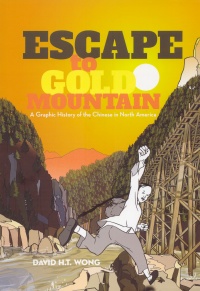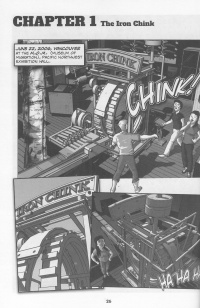| ________________
CM . . .
. Volume XIX Number 18. . . .January 11, 2013 
 |
Escape to Gold Mountain: A Graphic History of the Chinese in North America.
David H. T. Wong.
Vancouver, BC: Arsenal Pulp Press, 2012.
240 pp., trade pbk., $19.95.
ISBN 978-1-55152-476-4.
Subject Headings:
Chinese-Canada-History-Comic books, strips, etc.
Chinese-Canada-History-Juvenile literature.
Chinese-United States-History-Comic books, strips, etc.
Chinese-United States-Juvenile literature.
Graphic novels.
Grades 6-11 / Ages 11-16.
Review by Val Ken Lem.
*** /4
|
| |
|

excerpt:
Victoria, BC
December 14, 1885
Mimi, this is Victoria, Canada
There are many Chinese living here. Father and I once lived here.
Ai Yah! I haven't written to father in Tan Heung San [Hawai'i]! How disrespectful of me!
Dear Father, I trust you are well. I have returned to Victoria...and with a wife, her name is Mimi...
Most works on the history of the Chinese in North America deal exclusively with experiences in Canada or the United States. Wong is very ambitious to tackle the history of Chinese in both geographic regions, spanning developments from the 1830s to the present day. This approach is a valuable one as it illustrates racial discrimination that flourished in both countries and the fact that some of the early immigrants lived in more than one country in North America. Events such as the passage of the Chinese Exclusion Act of 1882 in the USA contributed to the influx of Chinese immigrants into Canada until 1923 when the Canadian government passed the Chinese Immigration Act that severely restricted immigration from China until it was repealed in 1947. Wong bases the graphic novel on real events and real members of his family, but it is a work of fiction and includes imagined encounters with historical figures Emily Carr and Sun-Yat Sen. The historical content is well researched and enlightening.
Wong is a Vancouver-based architect and urban ecologist with a passion for his Chinese heritage. His use of family history is a convenient way to introduce the story. It begins with contemporary children asking their grandmother about their ancestry, and she takes them to a Pacific coast museum where they discover the "Iron Chink," an early 20th century salmon gutting and cleaning machine that was marketed for its ability to replace 40 Chinamen per hour in the canneries along the coast. Soon the reader learns about Britain's opium wars with China in the mid-1800s and the extreme poverty in southern China that drove men, like Wong's ancestor, to seek a better life in a new land. The discovery of gold in California helped to establish the name Gold Mountain by which Chinese came to call America. Chinese workers provided cheap labour for businesses building the trans-American railway. When this was completed, workers faced exclusionist policies and physical violence, including several massacres, riots and torching of Chinatowns. Later, the need for cheap labour led to an influx of Chinese workers into Canada to assist with construction of the CPR through the mountains of British Columbia. As in the United States, completion of the railway led to large numbers of unemployed Chinese and white workers and competition for the jobs available. Head taxes, exclusionist laws and sometimes violence ensued. Death on the job claimed many more lives than the racially motivated murders recounted in the volume.
The last sixty years are covered in a quick succession of short chapters highlighting the work of Chinese North American activists who helped to change policies and attitudes towards the Chinese. Many significant firsts are noted as residents of Chinese heritage were elected to public office, played in professional sports, graduated from professional programs and helped to bring about further changes to immigration rules. Families were united, old foes became friends, and eventually in June 2006, the Government of Canada apologized for the Canadian Head Tax on Chinese immigrants and subsequent exclusion. In an Afterword, Wong records that, in October 2011, the US Senate unanimously passed a resolution expressing regret for the Chinese Exclusion Act of 1882, and the US House of Representatives likewise unanimously passed the resolution in June 2012.
 Chapters are short, and the drawings of specific people and events are authentic and often very detailed. Wong includes extensive notes and references, including a bibliography (with urls when available) and list of relevant websites for further study. Additional features that add to the value of the work as a work of history are the timeline, travel map, and prologue in the preliminary pages. The quality of the drawings is inconsistent. Many drawings are well executed, but others appear more quickly scratched and less realistic. Nevertheless, the graphic format has the potential to make history interesting to an audience that might avoid more traditional historic writing. Chester Brown proved with his highly successful Louis Riel: A Comic-strip Biography (Vol XI, No 21, June 24, 2005) that there is an appetite for Canadian history in this format. If the volume is reprinted, I hope that Wilfrid Laurier's name will be corrected (p. 134) and that the height of the mountains near Yale, BC, will be expressed in m rather than km (p. 111).
Chapters are short, and the drawings of specific people and events are authentic and often very detailed. Wong includes extensive notes and references, including a bibliography (with urls when available) and list of relevant websites for further study. Additional features that add to the value of the work as a work of history are the timeline, travel map, and prologue in the preliminary pages. The quality of the drawings is inconsistent. Many drawings are well executed, but others appear more quickly scratched and less realistic. Nevertheless, the graphic format has the potential to make history interesting to an audience that might avoid more traditional historic writing. Chester Brown proved with his highly successful Louis Riel: A Comic-strip Biography (Vol XI, No 21, June 24, 2005) that there is an appetite for Canadian history in this format. If the volume is reprinted, I hope that Wilfrid Laurier's name will be corrected (p. 134) and that the height of the mountains near Yale, BC, will be expressed in m rather than km (p. 111).
Recommended.
Val Ken Lem is a librarian with collection liaison responsibilities for English, history and Caribbean studies at Ryerson University in Toronto, ON, and the creator of an Asian Heritage in Canada website.

To comment
on this title or this review, send mail to cm@umanitoba.ca.
Copyright © the Manitoba Library Association. Reproduction for personal
use is permitted only if this copyright notice is maintained. Any
other reproduction is prohibited without permission.
NEXT REVIEW |
TABLE OF CONTENTS FOR THIS ISSUE
- January 11, 2013.
AUTHORS |
TITLES |
MEDIA REVIEWS |
PROFILES |
BACK ISSUES |
SEARCH |
CMARCHIVE |
HOME |

 Chapters are short, and the drawings of specific people and events are authentic and often very detailed. Wong includes extensive notes and references, including a bibliography (with urls when available) and list of relevant websites for further study. Additional features that add to the value of the work as a work of history are the timeline, travel map, and prologue in the preliminary pages. The quality of the drawings is inconsistent. Many drawings are well executed, but others appear more quickly scratched and less realistic. Nevertheless, the graphic format has the potential to make history interesting to an audience that might avoid more traditional historic writing. Chester Brown proved with his highly successful
Chapters are short, and the drawings of specific people and events are authentic and often very detailed. Wong includes extensive notes and references, including a bibliography (with urls when available) and list of relevant websites for further study. Additional features that add to the value of the work as a work of history are the timeline, travel map, and prologue in the preliminary pages. The quality of the drawings is inconsistent. Many drawings are well executed, but others appear more quickly scratched and less realistic. Nevertheless, the graphic format has the potential to make history interesting to an audience that might avoid more traditional historic writing. Chester Brown proved with his highly successful